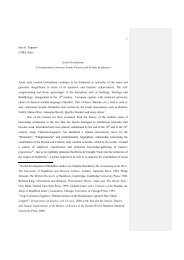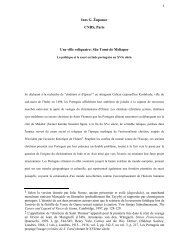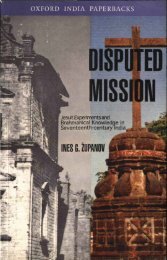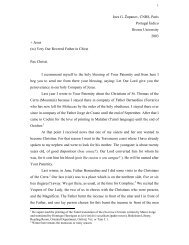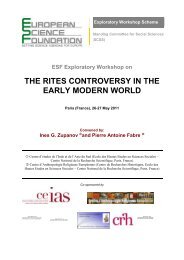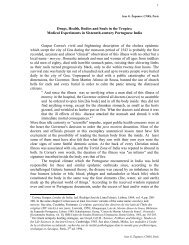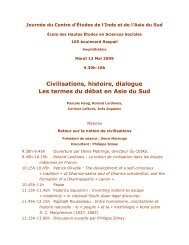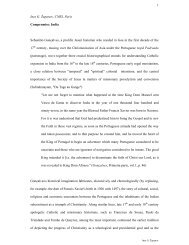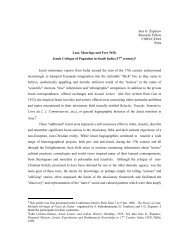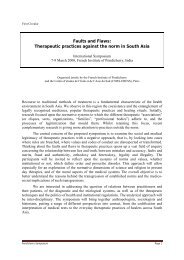Professional Missionary and Orientalist Curator ... - Ines G. Županov
Professional Missionary and Orientalist Curator ... - Ines G. Županov
Professional Missionary and Orientalist Curator ... - Ines G. Županov
Create successful ePaper yourself
Turn your PDF publications into a flip-book with our unique Google optimized e-Paper software.
206 <strong>Ines</strong> <strong>Županov</strong><br />
predecessor, a Jesuit Athanasius Kircher, «the last man who knew<br />
everything about everything», Paulinus was the last important Roman<br />
missionary Indianist . The institutional support <strong>and</strong> framework<br />
provided by the Propag<strong>and</strong>a Fide <strong>and</strong> by the patronage network of<br />
the Cardinal Stefano Borgia was crucial for Paulinus’ Indological<br />
oeuvre. When Borgia invited him to organize the Indian collection<br />
in his museum in Velletri, Paulinus became, at least for two decades,<br />
the most important Indologist of the Catholic world, <strong>and</strong> Rome became<br />
the center of European Indology 10 .<br />
Before <strong>and</strong> After <strong>Missionary</strong> Fieldwork<br />
A Catholic missionary life in the early modern period is usually<br />
divided into two or three stages: 1) before entering the order <strong>and</strong><br />
being sent to the mission – a stage that makes sense in the hagiographies<br />
only if endowed by premonitions <strong>and</strong> prophetic dreams <strong>and</strong><br />
visions; 2) a subsequent life in the mission, which is a heroic period<br />
of fatigue <strong>and</strong> eventual martyrdom; 3) for some, but not all, there is a<br />
third stage upon return to Europe or to some quiet place with a possibility<br />
of writing down recollections <strong>and</strong> reflecting on the mission<br />
fieldwork.<br />
After relatively unmemorable first phase, Paulinus a S. Bartholomaeo<br />
spent thirteen years between 1776-1789 as a missionary for the<br />
Propag<strong>and</strong>a Fide in South India. He described his missionary life in<br />
the Kerala region in the Viaggio alle Indie Orientali, printed in Rome<br />
in 1796 11 . During that time he travelled extensively, learnt both Sanskrit<br />
<strong>and</strong> other local vernacular languages, <strong>and</strong> met people from the<br />
lowest fishermen to kings of Travancore. Written with a hindsight, of<br />
course, Viaggio documents as much Paulinus’s travels <strong>and</strong> his missionantiquissimae<br />
gentilium orationes liturgicae paucis attinguntur et explicantur..., Romae,<br />
Ex Typographia Sacrae Congregationis de Propag<strong>and</strong>a fide 1790 [1791].<br />
<br />
For Kircher see Athanasius Kircher; The Last Man Who Knew Everything, ed. by P.<br />
Findlen, New York-London, Routledge 2004.<br />
10<br />
For Stefano Borgia’s museological enterprise see Le quattro voci del mondo: arte,<br />
cultura e saperi nella collezione di Stefano Borgia, 1731-1804, a cura di M. Nocca, Napoli,<br />
Electa 2001.<br />
11<br />
Paulinus a S. Bartholomaeo, Viaggio alle Indie Orientali, umiliato alla Santità di<br />
N.S. Papa Pio Sesto Pontefice Massimo..., Roma, Antonio Fulgoni 1796.




